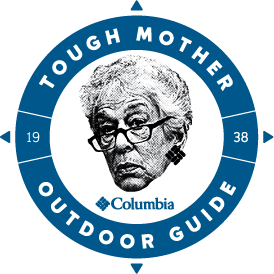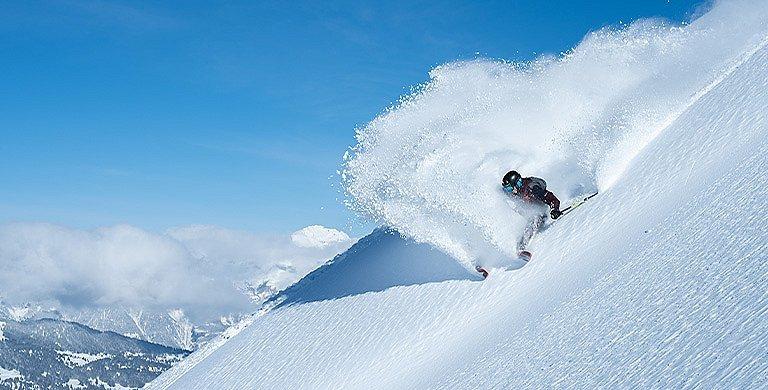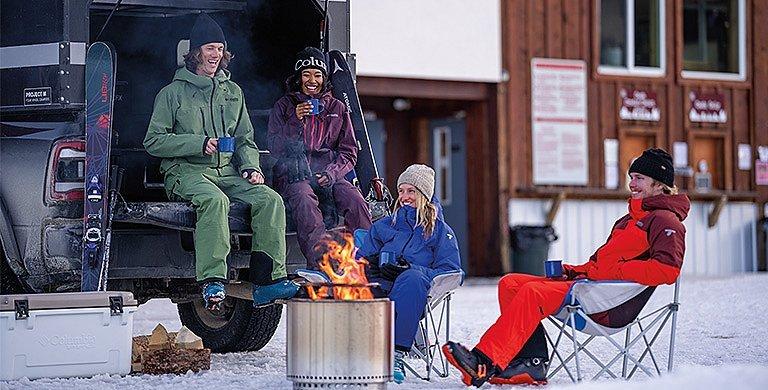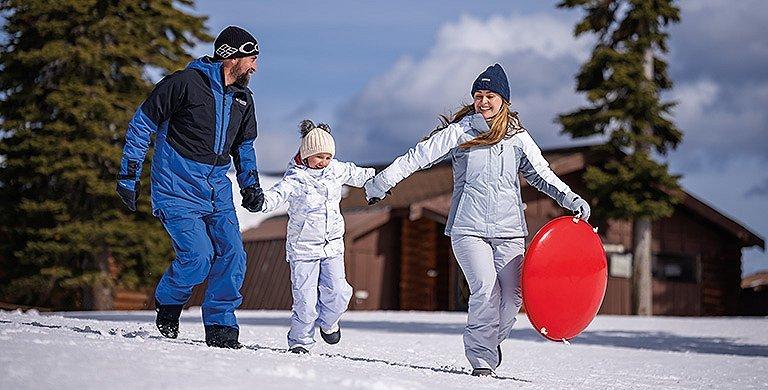SKI & SNOW
Helicopter and Snowcat Skiing and Snowboarding: Your Backstage Pass to Snowsports Nirvana
Is it time to escape the resort bubble and try snowcat or heli skiing and snowboarding?
BY: NANCY BOUCHARD
Skiing and snowboarding at a local hill or destination resort is a blast. You can rip groomers, send it in the park, and bond with chairlift buddies. Plus, lifts and gondolas do the uphill grind. But eventually, you may crave something more. If you’re dreaming of untouched powder, wide-open bowls, or steep couloirs, then consider leaving the resort crowd behind to explore the worlds of snowcat and helicopter skiing and boarding. While they’re not cheap, you’ll trade lift lines and finely groomed runs for vast backcountry, splendid isolation, and untracked powder.
Skiing and snowboarding are great sports however you practice them, but there’s something magical about being in the wild. As the father of helicopter skiing and co-founder of CMH Heli Skiing, Hans Gmoser (1932–2006), wrote, “In the end, to ski is to travel fast and free—free over the untouched snow-covered country. To be bound to one slope, even to one mountain, by a lift may be convenient, but it robs us of the greatest pleasure that skiing can give: that is, to travel through the wide wintry country; to follow the lure of the peaks which tempt on the horizon and to be alone for a few days or even a few hours in clear, mysterious surroundings.” Heli and snowcat skiing and boarding offer epic but accessible backcountry adventure, and, due to well-trained guides, improved weather forecasting, and first-rate equipment, it’s something that skiers and boarders from intermediates to experts can enjoy. Here’s what you need to know.
Skiing and snowboarding are great sports however you practice them, but there’s something magical about being in the wild. As the father of helicopter skiing and co-founder of CMH Heli Skiing, Hans Gmoser (1932–2006), wrote, “In the end, to ski is to travel fast and free—free over the untouched snow-covered country. To be bound to one slope, even to one mountain, by a lift may be convenient, but it robs us of the greatest pleasure that skiing can give: that is, to travel through the wide wintry country; to follow the lure of the peaks which tempt on the horizon and to be alone for a few days or even a few hours in clear, mysterious surroundings.” Heli and snowcat skiing and boarding offer epic but accessible backcountry adventure, and, due to well-trained guides, improved weather forecasting, and first-rate equipment, it’s something that skiers and boarders from intermediates to experts can enjoy. Here’s what you need to know.
A Quick History of Heli Skiing and Snowboarding
Skiing dates back centuries. Pioneers of the sport had to hike or use "skins" on the bottoms of their skis for uphill traction. Modern backcountry skiers still tackle ascents this way, though the effort limits how many runs you can squeeze into the day. Before lifts became commonplace, skiers often drove up mountain roads in their trucks, with someone driving down to pick them up at the bottom. By the 1930s, drag lifts like T-bars and rope tows made uphill travel easier, setting the stage for chairlifts and gondolas that added speed and comfort.
The 1960s saw a revolution in machine-accessed backcountry skiing when snowcats and helicopters began accessing vast backcountry terrain unreachable by traditional lifts. The first Sno-Cat, developed in Oregon in the 1940s, paved the way for its recreational use. In 1965, Hans Gmoser and his partners launched CMH in Canada’s Bugaboo Mountains; now the groundbreaking heli-skiing operation has access to three million acres in British Columbia—more territory than all the U.S. ski resorts combined.
Today, wide skis, bomb-proof bindings, comfortable boots, and warm, weather-proof apparel have made these adventures more accessible than ever. Outfitters offer everything from one-day outings (although sometimes you can book a single ride) to multi-day trips to remote lodges and yurts, with gourmet meals and epic après-ski.
The 1960s saw a revolution in machine-accessed backcountry skiing when snowcats and helicopters began accessing vast backcountry terrain unreachable by traditional lifts. The first Sno-Cat, developed in Oregon in the 1940s, paved the way for its recreational use. In 1965, Hans Gmoser and his partners launched CMH in Canada’s Bugaboo Mountains; now the groundbreaking heli-skiing operation has access to three million acres in British Columbia—more territory than all the U.S. ski resorts combined.
Today, wide skis, bomb-proof bindings, comfortable boots, and warm, weather-proof apparel have made these adventures more accessible than ever. Outfitters offer everything from one-day outings (although sometimes you can book a single ride) to multi-day trips to remote lodges and yurts, with gourmet meals and epic après-ski.
Snowcat Skiing
Snowcat skiing offers a backcountry experience without the climbing. Instead of the “earn your turns” mentality, you ride in a heated snowcat to pristine slopes. Many ski resorts now offer snowcat-accessed skiing and snowboarding to places their lifts don’t reach. If the resort doesn’t have an “in-bound” snowcat option, there may well be an operator nearby.
Riding a snowcat is an affordable alternative to helicopter skiing—about a quarter to half the cost—and it caters to a wider range of abilities. A single day can range from about $250 to over $1,000 per person, with better deals in early and late seasons. While Canada, Japan, Alaska, Montana, Wyoming, Utah, and Colorado are some of the most popular snowcat destinations, there are operations in most places where you'd find traditional ski resorts. While you don’t need to be an expert, you should feel comfortable on ungroomed slopes, glades, and in deep powder. A full-day trip can include some 8,000 to 12,000 vertical feet, depending on terrain and group speed.
Although snowcats are slower than helicopters, they’re ideal for those who prefer a relaxed pace. Safety protocols are rigorous, and guides provide training on avalanche gear, such as beacons and probes. Seth Masia, president of the International Skiing History Association and editor of Skiing History magazine, says that while snowcats are much slower than helicopters, they can get you to some incredible terrain. “Snowcats are a great first step to the backcountry,” says Masia. “In a snowcat, you have more time to rest between runs, compared to a helicopter, and you can warm up, defog your goggles, sip some hot chocolate, and hang out with friends.”
Riding a snowcat is an affordable alternative to helicopter skiing—about a quarter to half the cost—and it caters to a wider range of abilities. A single day can range from about $250 to over $1,000 per person, with better deals in early and late seasons. While Canada, Japan, Alaska, Montana, Wyoming, Utah, and Colorado are some of the most popular snowcat destinations, there are operations in most places where you'd find traditional ski resorts. While you don’t need to be an expert, you should feel comfortable on ungroomed slopes, glades, and in deep powder. A full-day trip can include some 8,000 to 12,000 vertical feet, depending on terrain and group speed.
Although snowcats are slower than helicopters, they’re ideal for those who prefer a relaxed pace. Safety protocols are rigorous, and guides provide training on avalanche gear, such as beacons and probes. Seth Masia, president of the International Skiing History Association and editor of Skiing History magazine, says that while snowcats are much slower than helicopters, they can get you to some incredible terrain. “Snowcats are a great first step to the backcountry,” says Masia. “In a snowcat, you have more time to rest between runs, compared to a helicopter, and you can warm up, defog your goggles, sip some hot chocolate, and hang out with friends.”
Heli Skiing and Snowboarding
Heli-skiing is the king of backcountry skiing and snowboarding adventure. It’s the most efficient way to get into the mountains and spend more time skiing. There’s no doubt that helicopter-accessed skiing and snowboarding is expensive—think double what you’d pay for a day of snowcat skiing—but you are virtually guaranteed great untracked snow and wild vistas. You can sign up for a luxury backcountry lodge experience for a week or more or save money by booking a single day trip. As Masia explains, “Heli-skiing is a magnet for powder lovers, offering the thrill of endless fresh tracks without the grueling climb. It may feel like cheating, but the sensory rush of raw, steep backcountry is irresistibly addictive.”
Heli-ski and snowboarding outfits have access to vast amounts of backcountry—tens of thousands of acres in the continental U.S. and millions in Alaska and Canada. Then there are places like the Karakoram, Himalayas, Andes, and Alps where prices are generally less expensive than in North America, but you have to get there first. You can heli-ski and snowboard on every continent—there’s even an outfit that runs trips to the Atlas Mountains of Morocco when conditions permit.
Masia notes that “Helicopters pretty much guarantee great snow as they can fly to where the conditions are good. If there’s sun crust on one side of a ridge, you can fly to the other side where the snow is light and dry. Guides know where the best conditions are and will take you to the prime spots.”
Soranne Floarea, spokesperson for CMH Heli-Skiing—which celebrates its 60th anniversary in 2025—says that the otherworldly feeling when the helicopter peels away, leaving you surrounded by a blanket of untouched snow and endless summits, is simply magic. “It’s gliding through the bottomless light, dry powder and the energy that fills the lodge after a day in the mountains, and the sense of camaraderie among the skiers and snowboarders. It’s truly the ultimate skiing or riding experience for anyone with a passion for powder.”
Helicopter ski and snowboard trips don’t require that you’re an expert skier, but you should be a strong intermediate. Floarea says that heli-skiing isn’t just for the pros—it’s for anyone with a passion for skiing or riding, ready to experience the best turns of their life. “In the past 60 years, we’ve guided more than 10 million runs,” Floarea explains. Most day tours involve from 12 to 20 thousand vertical feet—six to ten runs. Your guides are expert hosts with safety as their first priority.
Heli-ski and snowboarding outfits have access to vast amounts of backcountry—tens of thousands of acres in the continental U.S. and millions in Alaska and Canada. Then there are places like the Karakoram, Himalayas, Andes, and Alps where prices are generally less expensive than in North America, but you have to get there first. You can heli-ski and snowboard on every continent—there’s even an outfit that runs trips to the Atlas Mountains of Morocco when conditions permit.
Masia notes that “Helicopters pretty much guarantee great snow as they can fly to where the conditions are good. If there’s sun crust on one side of a ridge, you can fly to the other side where the snow is light and dry. Guides know where the best conditions are and will take you to the prime spots.”
Soranne Floarea, spokesperson for CMH Heli-Skiing—which celebrates its 60th anniversary in 2025—says that the otherworldly feeling when the helicopter peels away, leaving you surrounded by a blanket of untouched snow and endless summits, is simply magic. “It’s gliding through the bottomless light, dry powder and the energy that fills the lodge after a day in the mountains, and the sense of camaraderie among the skiers and snowboarders. It’s truly the ultimate skiing or riding experience for anyone with a passion for powder.”
Helicopter ski and snowboard trips don’t require that you’re an expert skier, but you should be a strong intermediate. Floarea says that heli-skiing isn’t just for the pros—it’s for anyone with a passion for skiing or riding, ready to experience the best turns of their life. “In the past 60 years, we’ve guided more than 10 million runs,” Floarea explains. Most day tours involve from 12 to 20 thousand vertical feet—six to ten runs. Your guides are expert hosts with safety as their first priority.
Equipment and Apparel
Snowcat and heli-skiing and snowboarding are designed to maximize access to powder. While an expert skier can handle pretty much anything on narrower skis, you’ll have an easier time with a wider ski. Consider a ski that’s 100cm to 120cm underfoot—the waist—as it will float on top of soft snow more easily than a narrower ski. You’ll also need a backpack for extra layers, water, and your snow safety equipment. Most snowcat and heli-ski operations have skis and avalanche gear available for guests to rent. You can also rent an avalanche airbag--—a backpack with an inflatable air bag that’s designed to keep you on top of the snow in case of an avalanche. It’s not foolproof by any means, but it’s another tool in your safety kit. Wear your warm ski and snowboard apparel, with an eye on layering. It’s a good idea to have a shell jacket, a warm mid layer, and snug baselayer. On the bottom, wear insulated pants or shell pants with a baselayer underneath. And don’t forget ski socks, gloves and a neck warmer. You’ll want a well-fitting helmet and goggles. Two pair of goggles is always a good idea in the backcountry in case one gets fogged up.
How Safe is Snowcat and Helicopter Skiing and Snowboarding?
Snowcat and helicopter skiing operations are strictly regulated in North America and Europe, with rigorous safety protocols for equipment, pilots, operators, and guides. While accidents are rare, they can happen. Heli-skiing involves flight, with the associated risks of aviation, while snowcat skiing eliminates that danger. However, both activities have the potential to expose you to the traditional dangers of skiing and riding, such as falls, tree wells, creeks, and sudden changes in the weather. Your guides will be clear about the potential hazards in the terrain where you are riding and skiing. The best advice is to listen carefully to your guide and follow all instructions. That way, you can get the most out of your day and focus on fun.



